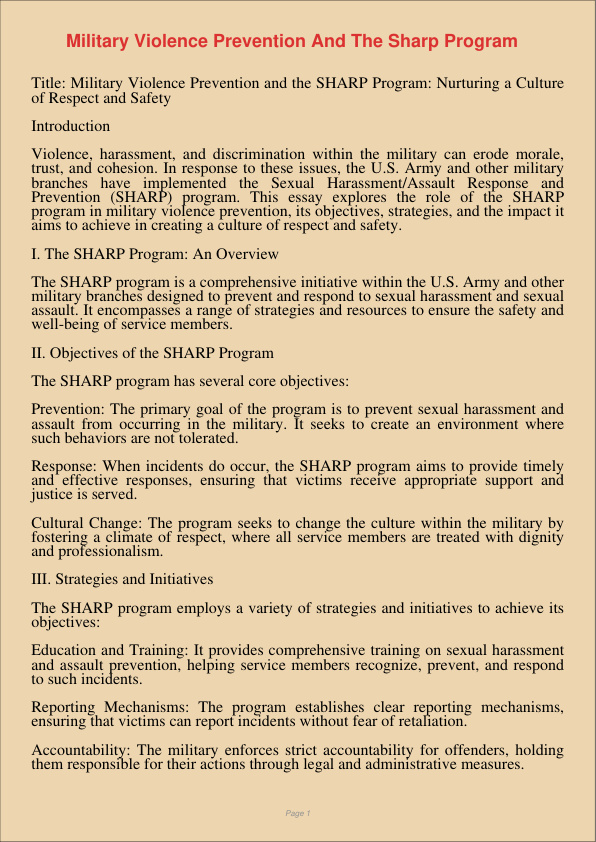Military Violence Prevention And The Sharp Program
Jan 12, 2024
military violence prevention
sharp program
Geography
Health Sciences & Medicine

Title: Military Violence Prevention and the SHARP Program: Nurturing a Culture of Respect and Safety
Introduction
Violence, harassment, and discrimination within the military can erode morale, trust, and cohesion. In response to these issues, the U.S. Army and other military branches have implemented the Sexual Harassment/Assault Response and Prevention (SHARP) program. This essay explores the role of the SHARP program in military violence prevention, its objectives, strategies, and the impact it aims to achieve in creating a culture of respect and safety.
I. The SHARP Program: An Overview
The SHARP program is a comprehensive initiative within the U.S. Army and other military branches designed to prevent and respond to sexual harassment and sexual assault. It encompasses a range of strategies and resources to ensure the safety and well-being of service members.
II. Objectives of the SHARP Program
The SHARP program has several core objectives:
Prevention: The primary goal of the program is to prevent sexual harassment and assault from occurring in the military. It seeks to create an environment where such behaviors are not tolerated.
Response: When incidents do occur, the SHARP program aims to provide timely and effective responses, ensuring that victims receive appropriate support and justice is served.
Cultural Change: The program seeks to change the culture within the military by fostering a climate of respect, where all service members are treated with dignity and professionalism.
III. Strategies and Initiatives
The SHARP program employs a variety of strategies and initiatives to achieve its objectives:
Education and Training: It provides comprehensive training on sexual harassment and assault prevention, helping service members recognize, prevent, and respond to such incidents.
Reporting Mechanisms: The program establishes clear reporting mechanisms, ensuring that victims can report incidents without fear of retaliation.
Accountability: The military enforces strict accountability for offenders, holding them responsible for their actions through legal and administrative measures.
Support Services: The program offers a range of support services, including counseling, medical care, and legal assistance for victims.
Leadership Involvement: It engages leaders at all levels to set the example and create a culture of respect within their units.
IV. Impact and Outcomes
The SHARP program has made significant strides in changing the military culture and preventing violence:
Increased Reporting: One positive outcome is the increased reporting of incidents, indicating that service members are more willing to come forward when they experience harassment or assault.
Improved Support for Victims: Victims now have better access to support services, ensuring their physical and emotional needs are met.
Cultural Shift: The program is contributing to a cultural shift within the military, where harassment and assault are increasingly seen as unacceptable and incompatible with military values.
Reduction in Incidents: While challenges persist, there is evidence that the program has contributed to a reduction in sexual harassment and assault incidents within the military.
V. Challenges and Ongoing Efforts
Despite the progress, the SHARP program continues to face challenges, including underreporting, a need for continued cultural change, and addressing the impact of power dynamics within the military. Ongoing efforts involve refining strategies, providing robust training, and ensuring leadership engagement to maintain and build upon the program’s success.
Conclusion
The Sexual Harassment/Assault Response and Prevention (SHARP) program is an integral part of military violence prevention. It seeks to create a culture of respect and safety within the military by preventing sexual harassment and assault, responding effectively when they occur, and fostering a climate where such behaviors are not tolerated. While challenges remain, the program’s impact on reporting, support for victims, cultural change, and the reduction in incidents highlights the progress made in creating a safer and more respectful military environment. It serves as a testament to the military’s commitment to addressing these issues and protecting the well-being of its service members.